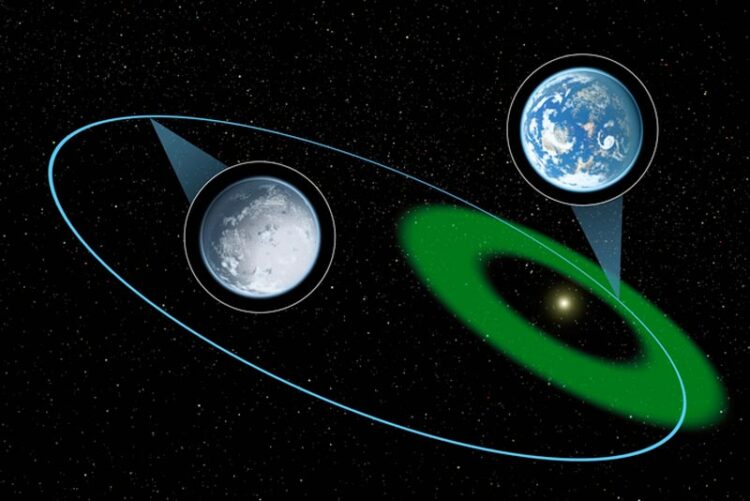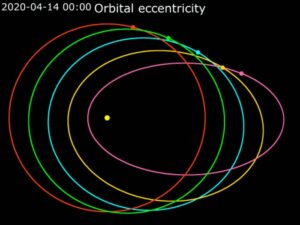Could more of Earth’s surface host life?

A habitable zone, shown in green here, is defined as the region around a star where liquid water, an essential ingredient for life as we know it, could potentially be present.
Credit: NASA/JPL-Caltech
Jupiter’s orbit shape plays key, overlooked role on Earth.
Of all known planets, Earth is as friendly to life as any planet could possibly be — or is it? If Jupiter’s orbit changes, a new study shows Earth could be more hospitable than it is today.
When a planet has a perfectly circular orbit around its star, the distance between the star and the planet never changes. Most planets, however, have “eccentric” orbits around their stars, meaning the orbit is oval-shaped. When the planet gets closer to its star, it receives more heat, affecting the climate.
Using detailed models based on data from the solar system as it is known today, UC Riverside researchers created an alternative solar system. In this theoretical system, they found that if gigantic Jupiter’s orbit were to become more eccentric, it would in turn induce big changes in the shape of Earth’s orbit.
“If Jupiter’s position remained the same, but the shape of its orbit changed, it could actually increase this planet’s habitability,” said Pam Vervoort, UCR Earth and planetary scientist and lead study author.

Credit: Phoenix7777
Between zero and 100 degrees Celsius, the Earth’s surface is habitable for multiple known life forms. If Jupiter pushed Earth’s orbit to become more eccentric, parts of the Earth would sometimes get closer to the sun. Parts of the Earth’s surface that are now sub-freezing would get warmer, increasing temperatures in the habitable range.
This result, now published in the Astronomical Journal, upends two long-held scientific assumptions about our solar system.
“Many are convinced that Earth is the epitome of a habitable planet and that any change in Jupiter’s orbit, being the massive planet it is, could only be bad for Earth,” Vervoort said. “We show that both assumptions are wrong.”
The researchers are interested in applying this finding to the search for habitable planets around other stars, called exoplanets.
“The first thing people look for in an exoplanet search is the habitable zone, the distance between a star and a planet to see if there’s enough energy for liquid water on the planet’s surface,” said Stephen Kane, UCR astrophysicist and study co-author.
During its orbit, different parts of a planet receive more or fewer direct rays, resulting in the planet having seasons. Parts of the planet may be pleasant during one season, and extremely hot or cold in another.
“Having water on its surface a very simple first metric, and it doesn’t account for the shape of a planet’s orbit, or seasonal variations a planet might experience,” Kane said.
Existing telescopes are capable of measuring a planet’s orbit. However, there are additional factors that could affect habitability, such as the degree to which a planet is tilted toward or away from a star. The part of the planet tilted away from the star would get less energy, causing it to be colder.
This same study found that if Jupiter were positioned much closer to the sun, it would induce extreme tilting on Earth, which would make large sections of the Earth’s surface sub-freezing.
It is more difficult to measure tilt, or a planet’s mass, so the researchers would like to work toward methods that help them estimate those factors as well.
Ultimately, the movement of a giant planet is important in the quest to make predictions about the habitability of planets in other systems as well as the quest to understand its influence in this solar system.
“It’s important to understand the impact that Jupiter has had on Earth’s climate through time, how its effect on our orbit has changed us in the past, and how it might change us once again in the future,” Kane said.
Journal: The Astronomical Journal
DOI: 10.3847/1538-3881/ac87fd
Method of Research: Computational simulation/modeling
Article Title: System Architecture and Planetary Obliquity: Implications for Long-term Habitability
Article Publication Date: 8-Sep-2022
Media Contact
Jules Bernstein
University of California – Riverside
Jules.Bernstein@ucr.edu
Office: United States
All latest news from the category: Physics and Astronomy
This area deals with the fundamental laws and building blocks of nature and how they interact, the properties and the behavior of matter, and research into space and time and their structures.
innovations-report provides in-depth reports and articles on subjects such as astrophysics, laser technologies, nuclear, quantum, particle and solid-state physics, nanotechnologies, planetary research and findings (Mars, Venus) and developments related to the Hubble Telescope.
Newest articles

NASA: Mystery of life’s handedness deepens
The mystery of why life uses molecules with specific orientations has deepened with a NASA-funded discovery that RNA — a key molecule thought to have potentially held the instructions for…

What are the effects of historic lithium mining on water quality?
Study reveals low levels of common contaminants but high levels of other elements in waters associated with an abandoned lithium mine. Lithium ore and mining waste from a historic lithium…

Quantum-inspired design boosts efficiency of heat-to-electricity conversion
Rice engineers take unconventional route to improving thermophotovoltaic systems. Researchers at Rice University have found a new way to improve a key element of thermophotovoltaic (TPV) systems, which convert heat…



